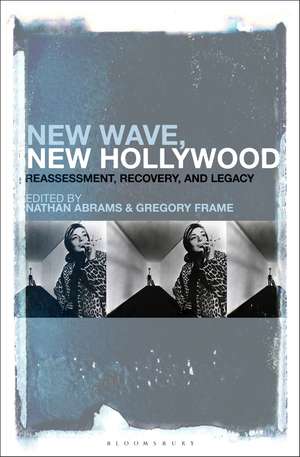New Wave, New Hollywood: Reassessment, Recovery, and Legacy
Editat de Professor Nathan Abrams, Dr. Gregory Frameen Limba Engleză Paperback – 19 apr 2023
| Toate formatele și edițiile | Preț | Express |
|---|---|---|
| Paperback (1) | 191.85 lei 6-8 săpt. | |
| Bloomsbury Publishing – 19 apr 2023 | 191.85 lei 6-8 săpt. | |
| Hardback (1) | 569.37 lei 6-8 săpt. | |
| Bloomsbury Publishing – 20 oct 2021 | 569.37 lei 6-8 săpt. |
Preț: 191.85 lei
Preț vechi: 249.64 lei
-23% Nou
Puncte Express: 288
Preț estimativ în valută:
36.72€ • 38.19$ • 30.31£
36.72€ • 38.19$ • 30.31£
Carte tipărită la comandă
Livrare economică 12-26 aprilie
Preluare comenzi: 021 569.72.76
Specificații
ISBN-13: 9781501372728
ISBN-10: 1501372726
Pagini: 272
Ilustrații: 15 bw illus
Dimensiuni: 152 x 229 x 25 mm
Greutate: 0.36 kg
Editura: Bloomsbury Publishing
Colecția Bloomsbury Academic
Locul publicării:New York, United States
ISBN-10: 1501372726
Pagini: 272
Ilustrații: 15 bw illus
Dimensiuni: 152 x 229 x 25 mm
Greutate: 0.36 kg
Editura: Bloomsbury Publishing
Colecția Bloomsbury Academic
Locul publicării:New York, United States
Caracteristici
Explores films, filmmakers and artists not otherwise considered part of the 'New Wave' in traditional scholarly accounts - Barbara Loden, Zucker-Abrahams-Zucker, Waldo Salt, Polly Platt, Julie Dash, and women working in marginalized, precarious positions in the special effects industry
Notă biografică
Nathan Abrams is Professor in Film at Bangor University in Wales. He is founding co-editor of Jewish Film and New Media: An International Journal, as well as the author of The New Jew in Film: Exploring Jewishness and Judaism in Contemporary Cinema, Stanley Kubrick: New York Jewish Intellectual, Eyes Wide Shut: Stanley Kubrick and the Making of His Final Film (with Robert Kolker) and The Bloomsbury Companion to Stanley Kubrick (with IQ Hunter).Gregory Frame is Teaching Associate in Film and Television Studies at the University of Nottingham. He is the author of The American President in Film and Television: Myth, Politics and Representation (2014). He has published articles about the politics of American film and television in Journal of American Studies, New Review of Film and Television Studies, and Journal of Popular Film and Television.
Cuprins
List of illustrations Notes on contributors Acknowledgments 1. IntroductionNathan Abrams and Gregory Frame 2. The Great Shift in Hollywood Cinema: Men, Women, and Genre Revisionismof the American New WaveFjoralba Miraka 3. Formal Radicalism vs. Radical Representation: Reassessing The French Connection (William Friedkin, 1971) and Dirty Harry (Don Siegel, 1971) Cary Edwards 4. A Wave of Their Own: How Jewish Filmmakers Invented the New HollywoodVincent Brook 5. New Hollywood's "Zany Godards": A "Shirley" Serious Assessment of Zucker-Abrahams-ZuckerEmilio Audissino 6. Design as Authorship: Polly Platt's New Hollywood AestheticAaron Hunter 7. "The Ultimate Fusion of Commerce and Art": Waldo Salt and Screenwriting in the 1970sOliver Gruner 8. Expanding the Past: Julie Dash and Zora Neale Hurston, African American Women filmmakers of New Hollywood and Early CinemaAimee Dixon Anthony 9. Lost in the Landscape: The Legacy of Barbara Loden's Wanda (1970) on the Contemporary American Independent Female Road MovieAimee Mollaghan 10. The New Wave in the New Millennium: Joker, Taxi Driver, Nostalgia, and Trumpian PoliticsKaren Ritzenhoff and Hannah D'Orso 11. Indie Courtship: Pursuing the American New WaveKim Wilkins 12. Afterword: New Wave, New Hollywood, New ResearchPeter Krämer Index
Recenzii
A fascinating array of essays aimed at revising our understanding of the Hollywood New Wave of the 60s and 70s.
A wide-ranging re-appraisal of the 'New Wave', which both underlines and questions its enduring significance for American film scholarship, and serves to reshape its parameters in important and timely ways. Essential reading for anyone wanting to understand this era and its vexed legacy.
A wide-ranging re-appraisal of the 'New Wave', which both underlines and questions its enduring significance for American film scholarship, and serves to reshape its parameters in important and timely ways. Essential reading for anyone wanting to understand this era and its vexed legacy.
